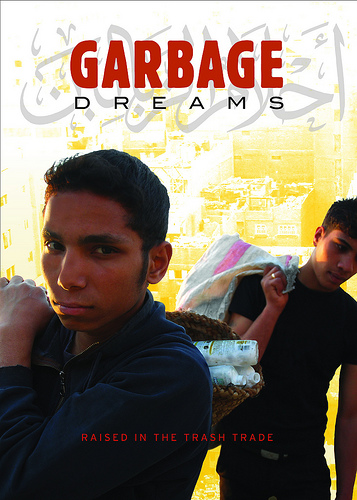Eighteen million people live in Cairo. They produce 13,000 tons of garbage every day, and they have no waste disposal system. Ew.
 Mai Iskander presents Al Gore with a drawing made by the children at The Recycling School in Cairo.Courtesy Garbage Dreams via FlickrBut the trash also presents an opportunity. For the past 50 years, one group of people in Cairo has made its living collecting and recycling one- to two-thirds of Cairo’s residential waste. Profiled in Mai Iskander’s new documentary film, “Garbage Dreams,” the Zaballeen — Arabic for garbage collectors — daily whisk trash bags from doorsteps in Cairo’s upper-class neighborhoods, bring the bags back to their own neighborhoods, and separate the recyclables from the rest of the waste. And at this task they are extraordinarily efficient.
Mai Iskander presents Al Gore with a drawing made by the children at The Recycling School in Cairo.Courtesy Garbage Dreams via FlickrBut the trash also presents an opportunity. For the past 50 years, one group of people in Cairo has made its living collecting and recycling one- to two-thirds of Cairo’s residential waste. Profiled in Mai Iskander’s new documentary film, “Garbage Dreams,” the Zaballeen — Arabic for garbage collectors — daily whisk trash bags from doorsteps in Cairo’s upper-class neighborhoods, bring the bags back to their own neighborhoods, and separate the recyclables from the rest of the waste. And at this task they are extraordinarily efficient.
Winner of the Al Gore Reel Current award for film, Garbage Dreams opens with jaw-dropping scenes of Mokottam, Cairo’s largest trash village. Piles of food waste and two-story mountains of aluminum cans clutter the streets. Pigs dart between trucks hauling crates of plastic bottles. While we ogle at how the Zaballeen could possibly live under a leaning tower of pizza boxes, Iskander notes that of all the waste we see in that neighborhood, the Zaballeen recycle more than 80 percent of it. Point of reference: in the U.S. we’re lucky to recycle one-third of household waste [PDF].
The film follows Adham, Nabil, and Osama, three teenage boys trying to make a living in the garbage trade, and Laila, a community social worker who liberally dispenses tetanus shots and tries to organize the Mokottam community into a more modern business operation. Laila’s work becomes more and more critical in the film as the city of Cairo grants contracts to foreign multi-national waste haulers, thus depriving the Zaballeen of the trash that provides their income.
As trash disappears, tense community meetings take place. Many Zaballeen believe that they need to modernize and out-compete the waste-haulers, while others argue that the incursion of the foreign companies represents the end for their way of life. Iskander deftly balances these competing points of view with confessional-style interviews, and evocatively portrays the financial and personal crises squeezing the Zaballeen (not to mention environmental crisis brought on by the fact that the waste haulers were only contracted to recycle 20 percent of collected waste.)
But the film is not all gloom and doom. Spliced in between the scenes of combative community meetings, Iskander highlights the Recycling School in Mokottam where Zaballeen children learn to read, to break down plastic bottles, and to create Excel spreadsheets (maybe they can tutor me?). After the waste-haulers came to Cairo, the school organized a field trip to show the children the large landfills where the foreign companies dumped the waste — recyclables and all.
To its detriment, Garbage Dreams begins with a touch of a sob-story sentiment. At one early point a young man sighs on a voiceover that he never wished to be born a Zaballeen. But after the introduction of the foreign waste haulers, the narrative of the film markedly shifts from a story about the stigma of being garbage collectors to a story about how to capitalize on the business opportunity that waste presents.
If you’re not sold already on watching how a community disposes of a mountain of soda bottles, it’s totally worth the $11 and 80 minutes to see Adham’s reaction when he learns that the people of Wales (and most other places in the West, for that matter) recycle less than half of what the Zaballeen do.
Watch It: Garbage Dreams is showing at the Seattle International Film Festival on June 9 and 10. Check the SIFF schedule for details.
For readers outside of Seattle, check the Garbage Dreams website for details on other screenings.



